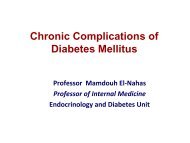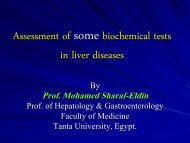CT Enterography
CT Enterography
CT Enterography
Create successful ePaper yourself
Turn your PDF publications into a flip-book with our unique Google optimized e-Paper software.
Inflammatory bowel disease (IBD) is an<br />
idiopathic disease, probably involving an<br />
immune reaction of the body to its own<br />
intestinal tract.<br />
The 2 major types of IBD are ulcerative<br />
colitis (UC) and Crohn disease (CD).
Incidence of IBD varies, highest rates in<br />
developed countries and lowest in developing<br />
regions.<br />
<br />
Colder climate and urban areas have a greater<br />
rate than warmer climates and rural areas.<br />
Internationally, incidence of IBD is approximately<br />
2.2-14.3 cases per 100,000 person-years for UC<br />
and 3.1-14.6 cases per 100,000 person-years for<br />
CD. Overall, the combined incidence for IBD is 10<br />
cases per 100,000 annually
The pathophysiology of IBD is under<br />
active investigation. The common end<br />
pathway is inflammation of the mucosal<br />
lining of the intestinal tract, causing<br />
ulceration, edema, bleeding, and fluid<br />
and electrolyte loss.
Ulcerative colitis and Crohn disease have<br />
approximately equal mortality rates.<br />
The vast majority of studies indicate a small<br />
but significant increase in mortality<br />
associated with IBD.<br />
The most frequent cause of death in persons<br />
with IBD is the primary disease, followed by<br />
malignancy, thromboembolic disease,<br />
peritonitis with sepsis, and complications of<br />
surgery.
Diagnostic Approach
Stool Culture for bacterial pathogens, and<br />
Clostridium difficile.<br />
Pseudomembranous colitis is commonly<br />
superimposed on ulcerative colitis.<br />
50-80% of cases of acute terminal ileitis are<br />
due to Yersinia enterocolitis infections. This<br />
produces a picture of pseudoappendicitis.<br />
Yersiniosis also has a high frequency of<br />
secondary manifestations, such as erythema<br />
nodosum and monoarticular arthritis, similar<br />
to IBD.
An elevated WBC is common in patients with active<br />
inflammatory disease and does not necessarily<br />
indicate infection.<br />
Anemia may result from acute or chronic blood loss or<br />
malabsorption (iron, folate, and vitamin B-12) or may<br />
reflect chronic disease state.<br />
MCV can be elevated in patients taking azathioprine<br />
(Imuran) or 6-mercaptopurine (6-MP).<br />
Generally, the platelet count is normal, or it may be<br />
mildly to moderately elevated if active inflammation is<br />
occurring.
(ESR) is used as a surrogate marker for<br />
inflammation; an elevation above<br />
normal generally indicates the presence<br />
of an inflammatory response.<br />
The sedimentation rate is typically<br />
elevated and For most, but not all,<br />
patients has been used to monitor<br />
disease activity.
Has a significantly shorter half-life and<br />
thus rapidly decreases in response to a<br />
reduction in disease activity
Colonoscopy can determine extent and<br />
severity of colitis, assist in guiding treatment,<br />
and provide tissue to assist in the diagnosis.<br />
In skilled hands, colonoscope can<br />
frequently reach terminal ileum and assist in<br />
the diagnosis or exclusion of Crohn disease.<br />
Inflammation may occasionally occur in the<br />
terminal ileum in patients with ulcerative<br />
colitis; this is referred to as a backwash ileitis<br />
.
Risk of bleeding is increased<br />
in the presence of inflammation, and<br />
even mucosal biopsies may require<br />
cautery to limit bleeding.<br />
The risk of perforation is also increased,<br />
particularly in patients taking high doses<br />
of steroids long term.
(EGD) for evaluation of upper GI tract,<br />
particularly in patients with Crohn disease.<br />
<br />
Aphthous ulceration occurs in stomach and<br />
duodenum in 5-10% of patients with CD.<br />
Patients with IBD have higher complication<br />
rates than general population; informed<br />
consent obtained for endoscopy should<br />
mention bleeding and perforation as potential<br />
complications .
The major risk of this examination in<br />
patients with Crohn disease is the<br />
potential for the camera to become<br />
lodged at the point of a stricture, which<br />
could require operative intervention for<br />
removal.
Crohn’s disease of the small bowel in capsule endoscopy:<br />
multiple small ulcerations all over the ileum and jejunum,<br />
scarring alterations of the small bowel.
Inflammatory polyp<br />
Ileitis<br />
Crohn’s disease<br />
Linear Erosions
Tight jejunal inflammatory stenosis with deep ulcers and<br />
inflammatory polyps
UC involves the mucosa and the submucosa,<br />
with formation of crypt abscesses and mucosal<br />
ulceration. The mucosa typically appears<br />
granular and friable.<br />
In more severe cases, pseudopolyps form,<br />
consisting of areas of hyperplastic growth with<br />
swollen mucosa surrounded by inflamed<br />
mucosa with shallow ulcers.<br />
In severe UC, inflammation and necrosis can<br />
extend below the lamina propria to involve the<br />
submucosa and the circular and longitudinal<br />
muscles, although this is very unusual.
There is seen plenty of mononuclear inflammatory<br />
cells in the mucosa of large intestine. In addition,<br />
round granulomas (*) in the mucosa are visible.
pANCA and ASCA<br />
Perinuclear antineutrophil cytoplasmic<br />
antibodies (pANCA) ----- UC<br />
anti-Saccharomyces cerevisiae antibodies<br />
(ASCA) ----- Crohn disease.<br />
Patients with IBD who are seronegative appear<br />
to have a lower incidence of resistant disease.<br />
Currently, these markers are not sensitive<br />
enough to be used as screening tests for IBD,<br />
and a diagnosis on the basis of serologic<br />
markers alone is inappropriate
Omp C<br />
I2<br />
› IgG only<br />
› Recognize outer membrane porin C protein in E. coli<br />
› IgA only<br />
› Recognizes novel homologue of bacterial transcriptionfactor<br />
families from a Pseudomonas fluorescensassociated<br />
sequence<br />
Cbir 1 flagellin<br />
› IgG
calprotectin has potential as a screening<br />
procedure to differentiate between<br />
patients with IBS from other organic<br />
intestinal disease
Differentiate IBD from functional bowel disorders<br />
Accurately diagnose Crohn’s or UC in a patient<br />
with:<br />
› Severe colitis<br />
› Indeterminate colitis<br />
Predict disease course or complications in IBD<br />
› CD phenotype<br />
› Severity of disease<br />
› Risk of pouchitis
Radiological Investigations
Edematous, irregular colon with "thumb<br />
printing." Occasionally, pneumatosis coli<br />
(air in the colonic wall) may be present.<br />
Toxic megacolon
‣ Normal barium enema findings exclude active UC,<br />
whereas abnormal findings can be diagnostic.<br />
<br />
<br />
<br />
<br />
A lead-pipe appearance, suggests UC<br />
Rectal sparing, suggests Crohn colitis in the presence of<br />
inflammatory changes in other portions of the colon<br />
Thumbprinting, indicates mucosal inflammation<br />
Skip lesions, again suggesting Crohn colitis<br />
‣ Barium enema is contraindicated in patients with<br />
moderate to severe colitis, because it risks perforation or<br />
precipitation of a toxic megacolon.
The small bowel series is usually sufficient<br />
for the evaluation of small intestine<br />
Crohn disease; however, rarely, it can<br />
afford an inadequate view of the<br />
terminal ileum, necessitating an<br />
enteroclysis
The enteroclysis differs from a small<br />
bowel series in that a nasoenteric tube is<br />
placed and contrast material is instilled<br />
directly into small intestine.<br />
Usually performed when fine detail of the<br />
intestinal mucosa is required or the distal<br />
small intestine is not adequately seen on<br />
the small bowel series .
› Widely used to evaluate for abscess<br />
› Mesenteric fatty proliferation<br />
› May show strictures but wall thickening difficult to<br />
assess due to variable distension<br />
› not as sensitive in delineating fissure or fistula as<br />
barium studies<br />
› superior to barium in showing the extraluminal<br />
sequelae of Crohns
<strong>CT</strong> Enteroclysis<br />
› High volume positive contrast infused rapidly via tube<br />
› improves small bowel distension – sensitive for small<br />
lesions<br />
› Time consuming procedure to pass Enteroclysis tube<br />
› Need to use Fluoro room & <strong>CT</strong> scanner<br />
› Unpopular with patients (and radiologists !)
Axial <strong>CT</strong> enteroclysis examination demonstrates a segment of<br />
kinked bowel (arrowhead) and several adhesive bands<br />
across other segments (arrows). This patient had undergone<br />
several negative <strong>CT</strong> examinations previously
<strong>CT</strong> <strong>Enterography</strong><br />
› High volume (1200ml) negative oral contrast<br />
(VoLumen) over 1 hour<br />
› improves small bowel distension c/w regular <strong>CT</strong> or SIFT<br />
› Give IV contrast to evaluate bowel wall<br />
› Use thin section multislice <strong>CT</strong> cuts to generate 3D<br />
coronal and sagital views also<br />
› Well tolerated by patients, no need for jejunal tube
NORMAL SMALL BOWEL<br />
WITH VOLUMEN<br />
Coronal cuts simulate traditional SIFT view
Normal<br />
Terminal<br />
Ileum
Crohn’s<br />
Disease
Evaluate all<br />
abdomen<br />
organs as well<br />
as bowel
Magnetic Resonance<br />
MRI has become helpful in the detection<br />
and localization of ano-rectal CD<br />
Thin section coronal, axial and sagital<br />
sequences<br />
› can readily detect the presence of active<br />
distal colonic disease and perianal fistulae<br />
› T2 weighted fat saturated sequence<br />
› T1 weighted Gadolinium enhanced fat<br />
saturated sequence
A patient with Crohn<br />
disease. MRI<br />
enterography<br />
examination shows<br />
good opacification<br />
of the small and<br />
large bowel with<br />
thickening of the<br />
inflamed cecal wall<br />
(arrow)
Useful Newer Techniques evolving<br />
› <strong>CT</strong> <strong>Enterography</strong><br />
• Comprehensive evaluation of all bowel & solid organs<br />
› Magnetic Resonance<br />
• Useful for ano-rectal disease<br />
• Real-time MR has potential for detection of strictures<br />
Traditional imaging techniques still of value<br />
in selected cases









